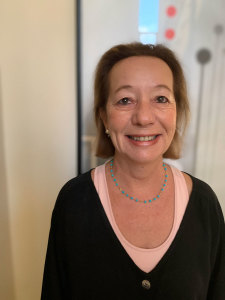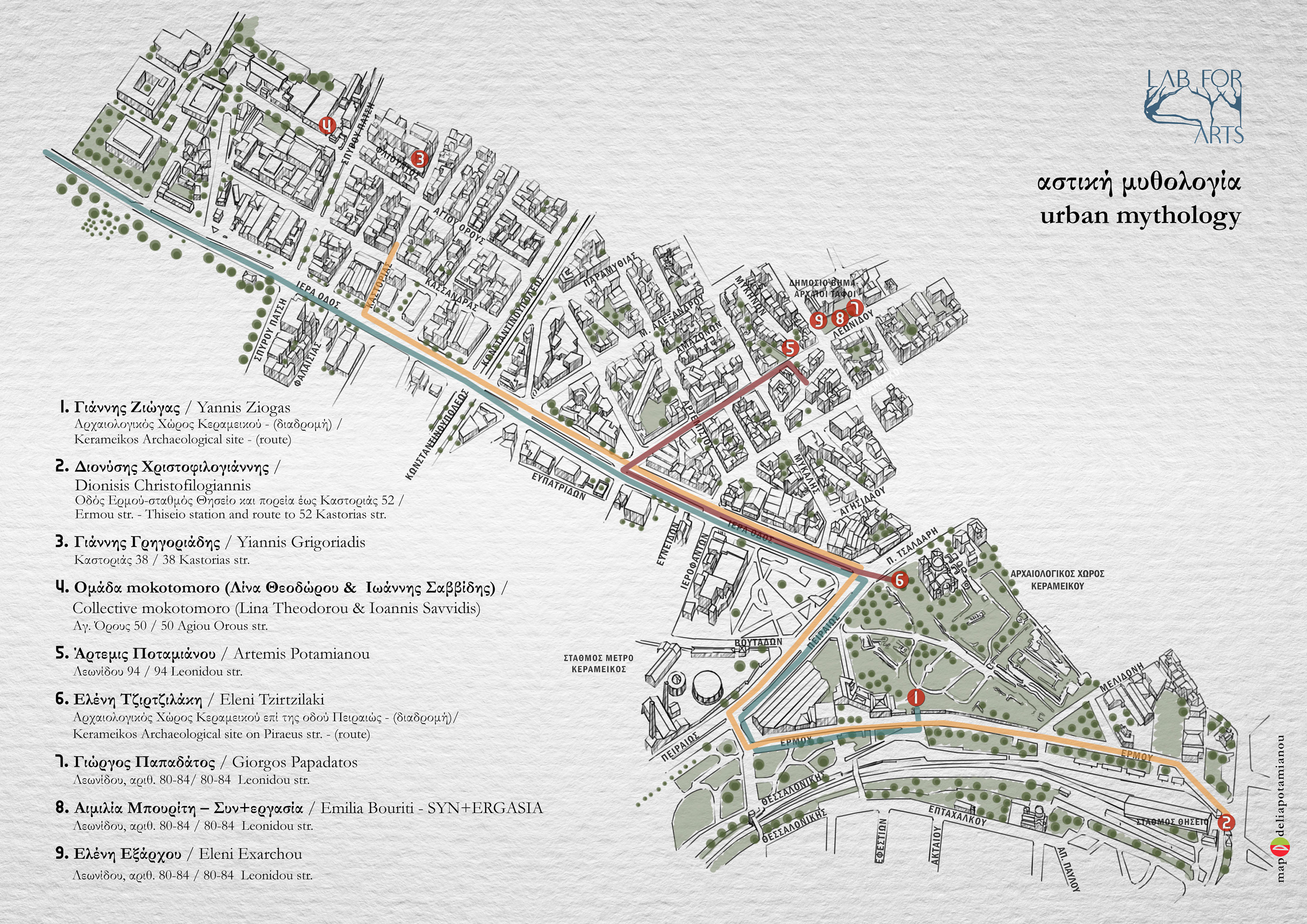INTERVIEW: Bia Papadopoulou
 The project “Urban mythology” that is starting today and lasts till Sunday 3, October, is a journey through space and time, with a very contemporary approach, since the participating artists are invited to create works in situ, which are directly related to the area of Kerameikos, the history of the place, the residents and the viewers, who are partakerσ and participants. This project is an idea by Artemis Potamianou that she is sharing curatorially with Bia Papadopoulou, who in the following interview, describes how the idea, the path and its implementation unfolds and evolves, while she explains to us the importance of the project in our time, that the need for communication, meeting and participation is greater than ever(!)
The project “Urban mythology” that is starting today and lasts till Sunday 3, October, is a journey through space and time, with a very contemporary approach, since the participating artists are invited to create works in situ, which are directly related to the area of Kerameikos, the history of the place, the residents and the viewers, who are partakerσ and participants. This project is an idea by Artemis Potamianou that she is sharing curatorially with Bia Papadopoulou, who in the following interview, describes how the idea, the path and its implementation unfolds and evolves, while she explains to us the importance of the project in our time, that the need for communication, meeting and participation is greater than ever(!)
By Efi Michalarou
Photo: Bia Papadopoulou’s Archive
The exhibition that you and Artemis Potamianou curate, is “Αστική Μυθολογία– Urban Mythology”. At a time when everyone is dealing with the 200 years since the Greek Revolution of 1821, you are dealing with an issue that is topical and timeless at the same time for our country and our Culture. How this idea emerged?
The exhibition’s idea belongs to Artemis Potamianou who invited me to collaborate as co-curator; she had been working on the concept for some time with her sister Delia Potamianou, the designer of the exhibition’s map and of the forthcoming catalogue. I accepted with joy since mingling art with urban space had been a major concern of mine since the first lockdown and the postponement or cancellation of shows in interior spaces. To this, I may add my interest in walking art as a new means of expression with particular potential.
The specific topos is full of historical traces, tempting one to enter in a dialogue. “Urban Mythology” looks at the past –not at the Greek Revolution, at antiquity. But it also looks at the present, attempting to open new windows to the future. I think that the show is fresh, inventive, alternative, and substantial. It attempts to overcome the epoch’s dystopia and the condition of enclosure while offering a breath of freedom to artists, an immediate contact with the audience and the local community.
We know the importance of Iera (Sacred) Odos as a Road that is directly connected with Athens, Eleusis and the Greater Eleusinan Mysteries, but your project focuses on the center of Athens, at the starting point of Iera Odos, someone would say and extends to Metaxourgio and Votanikos. Why did you choose this route and what does it mean for you?
We want to draw attention to an area that concerns not only the collective memory of the Greeks but also that of humankind. This area hosts the Dimosio Sima (Public Sign), the most important cemetery of ancient Athens with graves of the most prominent citizens of the 5th and 4th century B.C. and massive graves of those fallen for the country. The plot at 80-84 Leonidou street, where three of the performances take place (*1), was taken by eminent domain by the Ministry of Culture in order to form part of the cemetery’s archaeological site in the future. The aura transmitted by the land and the thought of what could be lying underground mesmerize visitors.
The route to Dimosio Sima began from Dipylon –one of the main entrances to ancient Athens, now within the archaeological site of Kerameikos– and ended at Plato’s Academy. The show includes works towards this direction. (*2)
The participating artist create artworks in situ and ephemerals. How important is that? As for the in situ we understand it, but why ephemeral?
This topos once hosted a plethora of ancient monuments; in dialogue with the space, artists propose works that function as “anti-monuments.” They defy the traditional myth of a monument as an architectural or sculptural building of monumental dimensions, made out of sturdy and expensive materials meant to last in time, a means of displaying wealth and power. The “anti-monuments” do not commemorate events; on the contrary, they criticize and denounce political and social conditions. They form codified visual narratives of the epoch. Their ephemeral and fragile character reflects the fluidity and uncertainty of the times while referencing our fleeting presence.
In the project the viewer is invited to follow the path of Giannis Ziogas, an artist who is initiated to the nature trails through the Peripatetic Conference organized every year in the Lake Prespa, here which path will follow? In Which direction he will guide the pushing the spectators?
Ziogas’ two hour walking action forms the second phase of his work. It takes place on Sunday, October 3rd, that is two weeks after the performances of September 19th, and is the only event of the day. Participants meet at the ruins of the ancient temple of Tritopatreion –within the archaeological site of Kerameikos–, they transverse part of Iera Odos and end their walk at the Agricultural University of Athens. This peripatetic venture exploits in full the geographical borders set by the exhibition. Upon their return, participants can wander around the area and visit the ephemeral works and the traces of the performances that remain in the city.
Eleni Tzirzilaki will perform at Keramikos and specifically at Iera Odos, her performace will explore the female condition, the concept of inclusion and the issue of mental health. What is the role of the viewer in this performance? How you and Artemis Potamianou have envisioned this role?
Defining the role of the viewer is the artist’s job, not the curator’s. It depends on the concept of the work. In Tzirtzilaki’s case all viewers can potentially become active participants in the project. In Women’s Case, presented here, the artist invites women from the audience and the neighborhood to share feelings and sew words concerning women’s skin and scars, on a fabric.
More artists in the show work in a participatory manner, activating the local community. This creates a wonderful feeling of solidarity, much needed today. I would like to stress the particular sensitivity of the locals in relation to their living space. With the citizens’ initiative, an activist act entitled “Dimosio Sima unites” was held in the area in 2011, an attempt to redevelop the area and accelerate excavation procedures. Ten years later, we share the same hope; that the excavations advance in order to bring forth this unique site, a major landmark of Athens.
Closing our conversation Mrs. Papadopoulou, after thanking you we would like you to tell us about your cooperation, how easy is for two curators with the same vision to find a balance? Where do your positions and opinions converge and diverge with those of Mrs. Potamianou in this project?
I have been working with Artemis efficiently for a number of years so I knew that our views on art are interestingly compatible. The result of an exhibition is molded in time, it doesn’t preexist. When a collaboration is turned into an act of co-creation, problems are solved and everything flows in ease. This is what happened with “Urban Muthology.”
Notes
- Giorgos Papadatos, Eleni Exarchou, Emilia Bouriti – syn+ergasia. Artemis Potamianou’s work in on 94 Leonidou street
- Yiannis Grigoriadis, collective mokotomoro (Lina Theodorou & Ioannis Savvidis), Dionisis Christofilogiannis
Download Greek Version of Interview here.
Info: Organizing team: Constantinos Constantinidis, Artemis Potamianou, Delia Potamianou and Bia Papadopoulou, Curators: Bia Papadopoulou and Artemis Potamianou, Duration:19/9-3/10/2021, www.lab4arts.eu


